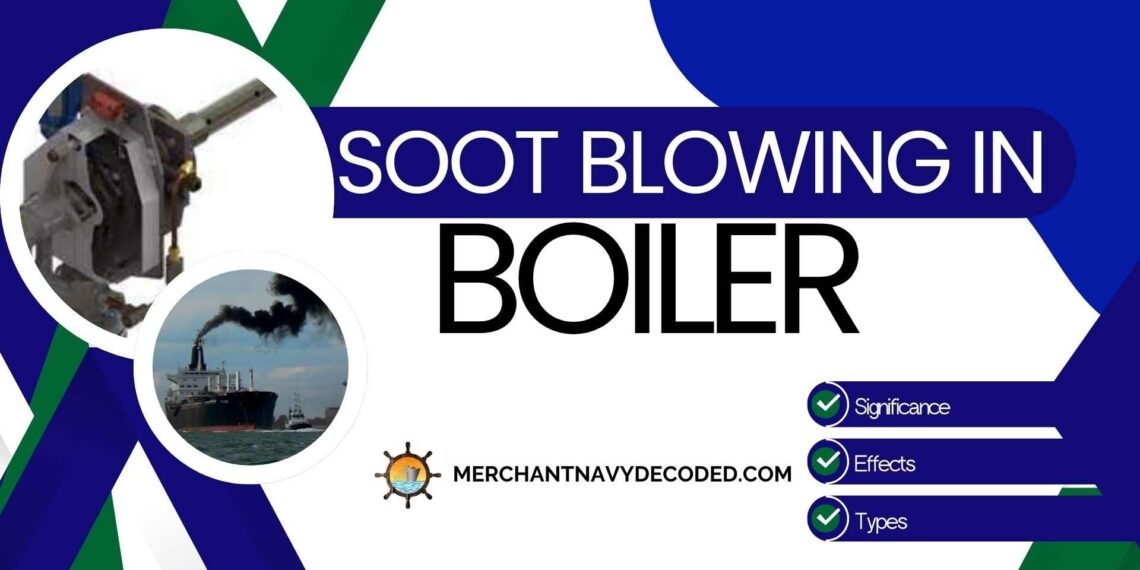Soot Blower in Boiler
Table of contents
- 1:- Overview
- 2:- What is Soot Blower in Boiler?
- 3:- What is Soot Blowing in Boiler?
- 4:- Soot Blower Function
- 5:- Effects of Not Doing Soot Blowing in Boiler
- 6:- Soot Blowing Procedure of Economizer through Steam
- 7:- Step-by-Step Procedure of Soot Blowing in Boilers
- 8:- Soot Blowing with Air
- 9:- Working Procedure of Air Soot Blower
- 10:- Location of Soot Blower in a Boilers
- 11:- Important Considerations
1:- Overview
Soot blowing is an important process commonly used in industries and related to boiler maintenance. This comprehensive article will look at what soot-blowing entails, the implications of not performing soot-blowing, how soot-blowing is done, and through which media; air and steam.
2:- What is Soot Blower in Boiler?
A soot blower is a system that assists in eliminating soot, ash, and all other combustion products that deposit onto the internal surfaces of boilers. It employs high-pressure steam or air or both to remove such deposits. In the process, it improves the efficiency of boilers; reduces emissions, and increases the operational life of boilers.
3:- What is Soot Blowing in Boiler?
Soot blowing is the procedure of removing soot and ash deposits along with other products of combustion from the boiler surfaces. It entails the application of high-pressure steam, air or both to wash out these deposits off the internal walls of the boiler and other associated items like tubes, fireside, and superheaters.
Soot Blow is a process that is used for Internal and Erosion control in boilers.
Click here to check out what are the types of Mounting used on Boiler.
4:- Soot Blower Function
- Improved Heat Transfer: Soot and ash deposit on the tube walls prevent the transfer of heat in the boiler. Soot blowing makes certain that the maximum heat is transferred to the water or steam hence high efficiency and fuel usage.
- Increased Boiler Efficiency: Better heat transfer results in increased steam output, which is associated with improved boiler efficiency and reduced expenditures.
- Prolonged Boiler Lifespan: Soot and ash are rough materials that, over time, can cut and rust most boiler parts. Soot blowing helps in minimizing wear and tear of the boiler thus increasing the life of the boiler.
- Reduced Emissions: When combustion and heat transfer rates are fine-tuned, soot blowing can reduce the emission of hazardous pollutants hence improving the environment.
- Enhanced Safety: Accumulation of a thick layer of soot often causes blockages and other dangerous conditions like tube rupture or explosion. Soot blowing eases these risks.
If you want to learn complete information regarding the operation of the Alborg Boiler, boiler automation, burner sequences, ALTC panel operation, and whatnot then check out our specially designed Boiler Course which will make you confident in operating and troubleshooting issues without any fear.
5:- Effects of Not Doing Soot Blowing in Boiler
Neglecting soot blowing can lead to a cascade of problems:
- Decreased Efficiency: With the deposition of soot and ash, the heat transfer property of the boiler reduces thus the steam generated and more consumption of fuel.
- Increased Downtime: Soot deposition requires frequent and unplanned maintenance and cleaning, which is not desirable for operations and is costly in terms of downtime.
- Component Failure: Soot and ash accumulation have an impact on the corrosion, erosion, and overheating of the boiler tubes; hence, its deterioration and expensive replacement of the tubes.
- Safety Hazards: The buildup of soot, and gas can block the passages leading to pressure build-up and thus causing explosions and other mishaps.
- Environmental Impact: Soot deposits on the combustor walls retards combustion and enhance the emission of pollutants into the atmosphere and hence cause environmental problems.
6:- Soot Blowing Procedure of Economizer through Steam
6.1:- Preparation for Soot Blowing in Boilers:
- Make sure you have stabilized the boiler load.
- Steam to the economizer will be extracted from a point on the primary steam circuit as explained below.
- Port the economizer inlet and outlet dampers as well as its motor control center.
- Turn the soot blower steam supply valve with the handle in an anticlockwise direction.
6.2:- Soot Blowing Sequence:
- Perform soot blowing starting from the cold end of the economizer where feed water is introduced to it.
- Every soot blower should be turned on one by one from the cold end towards the hot end.
- Ensure that steam pressure is enough at each of the steps.
- The parameters of the boiler should be observed, for any changes in their readings.
6.3:- Completion of Soot Blowing in Boilers:
- Finally, if the usage of soot blowers is complete, turn the steam supply valve off.
- Fully open the inlet and outlet dampers of the economizer.
- Again connect the economizer to the main steam circuit.
- General Soot Blowing Procedure
7:- Step-by-Step Procedure of Soot Blowing in Boilers
1. Safety Checks: Ensure that all the employees are out of the soot-blowing area and that all appropriate measures have been put in place.
2. Isolation: Prevent water in the boiler from being contaminated by offering a section that requires cleaning.
3. Activation: Turn all soot blowers on in an escalating order beginning at the gas inlet section and finishing at the gas outlet section.
4. Monitoring: Monitor other parameters associated with the operating performance of the boiler including pressure, temperature, and the composition of the flue gases for any peculiarities.
5. Completion: Following the blowing of all soot blowers, turn off the valve of supply steam or air, and reconnect the cleaned section back to the boiler.
8:- Soot Blowing with Air
Air soot blowing is a viable alternative to steam blowing, particularly in scenarios where steam production is limited or the boiler size doesn’t warrant the complexity of a steam system. It offers a simpler and more cost-effective approach to removing soot and ash deposits.
9:- Working Procedure of Air Soot Blower
1. Compressed Air Supply:
- The foundation of air soot blowing is a reliable source of compressed air. This can be achieved using:
- Dedicated Air Compressor: Many facilities have compressors specifically for soot blowing. These compressors are typically designed to deliver high-pressure air (often around 100-150 psi) in sufficient volume to effectively clean the boiler surfaces.
- Plant Air System: In some cases, the existing plant air system can be utilized for soot blowing if it meets the pressure and volume requirements.
2. Soot Blower Design:
Air soot blowers are similar in design to steam blowers but are optimized for using compressed air. They consist of:
- Nozzle: The nozzle directs the high-pressure air jet towards the soot and ash deposits. The nozzle design (e.g., lance type, rotating, etc.) varies depending on the specific application and boiler geometry.
- Lance Tube (Optional): Some air soot blowers utilize a lance tube to extend the reach of the nozzle deeper into the boiler.
- Valve: A valve controls the flow of compressed air to the nozzle.
3. Process of Soot Blowing with Compressed Air:
The air soot-blowing process is relatively straightforward:
- Preparation: As with steam blowing, the boiler is typically operated at a stable load before commencing soot blowing. The section to be cleaned is isolated, and safety checks are performed.
- Activation: The soot blower valve is opened, allowing the compressed air to flow through the nozzle. The high-velocity air jet impacts the soot and ash deposits, dislodging them from the boiler surfaces.
- Sequence: Soot blowers are activated in a specific sequence, usually starting from the gas inlet side and progressing towards the gas outlet. This ensures that dislodged deposits are carried away by the flue gas.
- Monitoring: Boiler parameters (e.g., draft, flue gas temperature) are monitored during the process to ensure safe and effective cleaning.
- Completion: Once all soot blowers have been operated, the air supply is shut off, and the cleaned section is reintegrated into the boiler circuit.
10:- Location of Soot Blower in a Boilers
Soot blowers are strategically located throughout the boiler, including:
- Water Walls: These isolate the furnace walls and get directly exposed to the largest amount of thermal radiation. Soot blowers here help in avoiding case buildup on the walls, especially when the boilers are protected against excessive heat transfer so that heat is conserved and transferred efficiently to other parts of the plant.
- Superheaters and Reheaters: These raise the steam temperature; soot deposition can affect them greatly.
- Economizer: This pre-warms the water to be supplied to the boiler and anything that clogs the tubes will contribute to less efficiency.
- Air Heaters: These preheat the combustion air, and clean surfaces make for heat recovery.
11:- Important Considerations
- Frequency: It is also observed that the intervals of soot blowing vary with the type of fuel, and the design and operational conditions of the boiler. It is, however, important to note that, to function at its best the lung has to be blown at fixed intervals.
- Maintenance: Soot blowers however are necessary structures and also call for periodic maintenance for their proper functioning. That involves checking nozzles, wiping a steam or airline, and replacing the badly worn parts.
- Automation: Some of the elaborate boilers currently in the market are fitted with soot blower auto control comprising of cycling and timing gadgets that control the soot-blowing cleaning regime thus minimizing the frequent, direct human interference while at the same time guaranteeing efficiency.
Disclaimer :- The opinions expressed in this article belong solely to the author and may not necessarily reflect those of Merchant Navy Decoded. We cannot guarantee the accuracy of the information provided and disclaim any responsibility for it. Data and visuals used are sourced from publicly available information and may not be authenticated by any regulatory body. Reviews and comments appearing on our blogs represent the opinions of individuals and do not necessarily reflect the views of Merchant Navy Decoded. We are not responsible for any loss or damage resulting from reliance on these reviews or comments.
Reproduction, copying, sharing, or use of the article or images in any form is strictly prohibited without prior permission from both the author and Merchant Navy Decoded.



